Take a look at this photo:
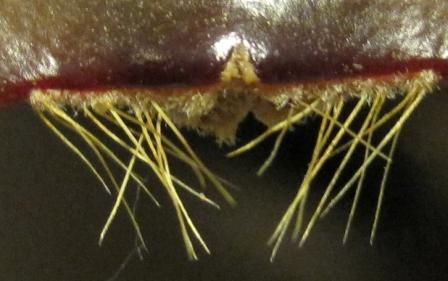
This is a two part quiz: on what plant would you find these hairs, and what are these hairs called?
Answers on Monday!
Nobody in their right mind considers pesticides safe. They are, after all, poisons which we have created to kill things, be those things plants, insects, fungi, rats, or whatever. The idea that we could have foods with no pesticides on them is attractive. Now I’ve got to admit that, as a general rule, I don’t think that the levels at which most pesticides are found on foods is concerning. Our methods of detecting poisons are just too sensitive today and so we end up saying that a poison is “present” on a tomato or whatever even if it’s there at a harmless parts-per-trillion level. Still, I won’t deny that I’d prefer it if there were no synthetic pesticides on any food.
A couple of days ago a report came out from CNN about the “dirty-dozen.” http://www.cnn.com/2010/HEALTH/06/01/dirty.dozen.produce.pesticide/index.html This is a list of the twelve fruits and vegetables which are most likely to have detectible levels of synthetic pesticide residues. Along with this list there is a suggestion that, when purchasing these fruits and veggies, you should select those that are organically produced whenever possible. I don’t have a problem with this list being reported. In fact, I think it’s a good idea to give people all of the information that we can about pesticides. While I, personally, am not particularly afraid of conventionally produced fruits and veggies because of the synthetic chemicals which they may contain I appreciate the fact that others might be. I do, however, have a major problem with the idea that organically produced fruits and veggies are necessarily safer than those produced with synthetics. You see, organically produced food is not tested for residues of potentially damaging organic pesticides, and those same foods that are slathered by synthetic pesticides in non-organic growing systems are typically slathered by organic pesticides in organic systems, particularly if you’re dealing with foods produced using what has become known as “industrial organic production” which fill most of our large grocery stores with USDA Certified Organic Produce nowadays. These organic pesticides may be present at higher concentrations than synthetic pesticides and may have similar effects on humans, and even worse effects on the environment than synthetics (though it depends on the exact pesticides used and how often they are used of course).
The myth that organic foods don’t have pesticides used on them is one that really needs to die. No farmer, organic or non-organic, wants to use pesticides, and sometimes they can get away without using them. Certain crops are rarely sprayed regardless of whether they’re produced organically or not. Pesticides cost money and are dangerous, but when faced with the potential loss of a crop producers will do what they need to do to avoid losing their crop, and if that means applying pesticides then so be it. Organic farmers may choose to use different pesticides, and they might wait longer before they spray (although often they spray sooner because the relative efficacy of their sprays are inferior to synthetic sprays) but let’s not say that organically produced foods are free of pesticide reside. Just because we’re not testing for it doesn’t mean it isn’t there.
With increasing interest in reducing monocultural swaths of turf, summer water consumption, and the drudgery of mowing, many people are eliminating part or all of their lawns. We did this at home some years ago and can attest to the tangible benefit of reduced water bills during our dry summer months.
The question I often get is – how? Do you dig up the turf and throw it out, then fill in with topsoil? Or do you cut it, flip it, and then plant on top of it? Or do you cover it up with cardboard to kill it?
We’ve tried all of these methods over the years (except sheet mulch, because you already know what I think about that). What I now recommend is the easiest, cheapest, and most effective way to both remove turf and protect the soil. Here it is in four easy steps:
1) Mow your lawn as close to the ground as possible. Scalp it. If you can wait until it’s not actively growing (summer here in the west), that’s even better. Don’t water it!
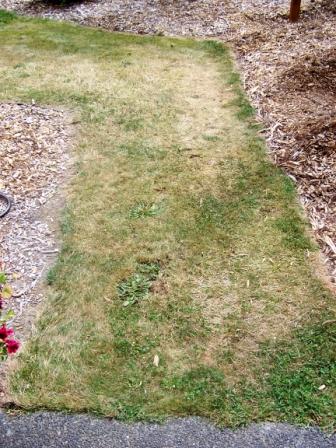
2) Cover it up with – yes, you guessed it – a really thick layer of arborist wood chips. They need to be at least 8″ thick and can be as much as 12-18″ deep without negative effects. They will settle quickly, so you do need to put enough down to maintain a 6-8″ depth after a few weeks. The depth is important to suppress the turf as well as any persistant weeds (like those you can see in the above photo).
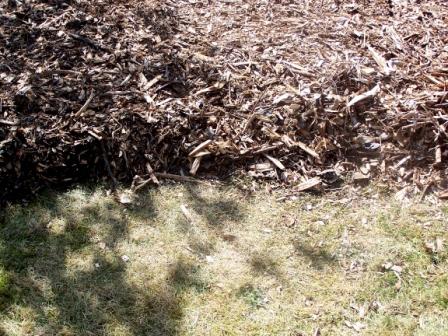
3) Wait. Turf decomposition will depend on temperature and water availability – warm and moist conditions are optimal. After 2-4 weeks, pull part of the mulch back and check out what’s underneath. When it’s easy enough to dig through, then you can…
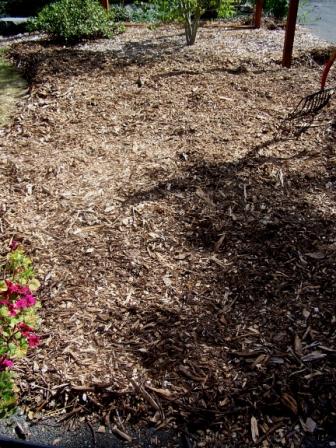
4) Plant. Be sure to move the mulch aside and plant into the soil. Replace the mulch to cover the disturbed soil and keep the weeds down. It only needs to be 3-4″ deep at this point.
It’s that easy.
As retirements have decimated our Horticulture Department’s faculty ranks, I find myself in the interesting position of teaching a course in small fruit production next fall semester. I’m working on the syllabus as was speak (hence this post). If you’ve read my bio (“About Us”), you’ll see that this is not my bag. But our students are clamoring for fruit and vegetable production courses, so someone’s got to do it. We are also currently without on-campus vegetable faculty, if you can believe it. Though I know a few full professors that could pass as vegetables – HA!!!.
Anyhoo, I volunteered because I know just enough to be dangerous, and am willing to learn more. I’ve been an avid home vegetable gardener
for years. My partner has a Ph.D. in small fruit breeding and genetics, and I helped him with some experiments back in our grad school days (and his field sampling/taste trials made me doubt my specialization in ornamentals). We now have a you-pick blueberry farm where I’m learning the finer points of blueberry culture (the pH thing is a really huge deal). All this vast experience obviously qualifies me to teach fruit production at the college level. I say this tongue-in-cheek, but many Horticulture departments are in the same boat, with early retirements used to meet budget shortfalls, compounded by hiring freezes (since 2007 here). Research staff, grad students, and hired instructors are picking up the teaching load and helping the already-spread-too-thin teaching faculty. I mentioned in a previous post about our brilliant state legislatures’ desire to eliminate urban Extension programs, leaving only the agriculturally–related specialists and offices.
This is depressing on many fronts, but what bothers me most is that I feel we’re missing the boat – just when Horticulture is getting sexy again. Think of how frequently this discipline is mentioned in the media, whether in the form of community gardens, safe food production, the popularity of native plants, sustainability, organics, etc….unfortunately, the writers/broadcasters rarely say the “Horticulture” word. But horticulture is exactly what they’re talking about: small-scale gardening and the art and science thereof. People want to do it, they’re thirsty for good information, and now, with the spotlight on us, we can’t meet their needs.
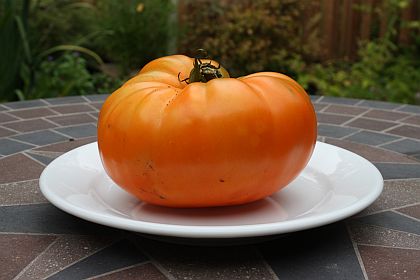
I can’t really think of an image appropriate to this rambling post, so will end this with a more cheerful photo of one of my tomatoes from last summer (variety is ‘Kellogg’s Breakfast’).
As part of our discussion of the relative merits of fall planting, Linda mentioned an article in Arboriculture and Urban Forestry that suggests that frequent, light irrigation might be better for landscape trees then the usual recommendation of infrequent soakings. While I will withhold final judgment until I see the article (I did a scan of the last two year’s table of contents for A&UF but missed the article in question), here’s my rational for following the standard recommendation.
First, the context. In discussing landscape tree irrigation I am talking about watering trees during establishment, typically during the first year after planting and maybe the second if the tree is lucky. The goal of watering in this case is ensuring survival. The questions are whether deep soakings are more likely to encourage deeper rooting where water availability is less variable than near the surface after irrigation ceases and whether infrequent watering increases drought tolerance over more frequent irrigation.
Roots follow resources
As my Woody Plant Phys students quickly learn, we avoid the teleological ‘roots seek out water’; nevertheless, roots do proliferate where resources are available. A couple of illustrations. As a Tree Physiology Project Leader with International Paper I supervised a 25 acre hardwood fertigation trial. Trees were watered daily via drip irrigation system with emitters spaced every 3’ down a row. As part of the study we did periodic root harvests. My technicians quickly learned it was an easy job: just look for the drip emitters – every three feet there was a mop of roots right next to the drippers. The notion of roots following resources is also widely reported in the ecology literature on tree utilization of ‘patchy resources’ (e.g. Gloser et al. 2008 Tree Phys 28:37-44 ). Other factors being equal deeper watering should result in deeper rooting.
Trees habituate to frequent irrigation
Another short rotation forestry example. In eastern Washington and Oregon forestry companies Potlatch and Boise Cascade operated intensively managed ‘fiber farms’ which grew 70’ tall, 7” diameter hybrid poplars on a 7 year rotation. To maintain these growth rates, trees were irrigated daily. But there was a downside: If one day’s irrigation was missed the leaders to the trees would start to wilt. Three days without water would result in leaf drop. The daily irrigation was great for growth but it turned the trees into physiological wusses.
Periodic water stress improves drought tolerance and survival
A common adaptation for trees to tolerate drought is osmotic adjustment, which is an active accumulation of solutes that enables plant cells to maintain turgor pressure during dehydration. Plants that have acclimated to stress via osmotic adjustments and other physiological adjustments are able to survive better during prolonged drought than plants that have not been pre-conditioned. For example ponderosa pine seedlings that had been subjected to brief drought events survived a terminal dry-down two weeks longer than seedlings that had been watered 3 times a week before the final dry-down (Cregg 1994 Tree Phys. 14:883-898.
What would it take to change my mind?
Obviously some of my examples here are anecdotal (though there’s plenty of hard data on osmotic adjustment and other drought conditioning effects on trees). To recommend frequent (2 or 3 times a week), shallow irrigation I would need to see: a well designed and executed experiment that compared frequent irrigation to periodic (once every 7-10 days) applying the same amount of water weekly (0.5 to 1” per week) for the first year and then documented improved survival of the trees after irrigation had been discontinued. I’m not saying it’s not possible but it goes against my personal observations with irrigated trees in a variety of settings and relevant data with which I’m familiar.
As Paul suspected, this is a Phalaenoposis flower. Here it is again, shown next to another flower on the same plant (but different stalk):
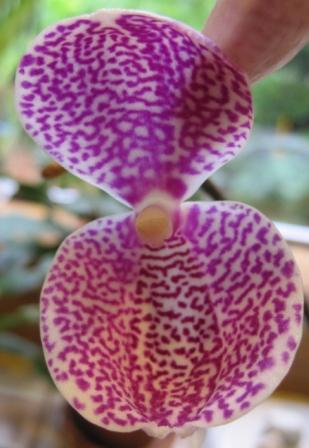
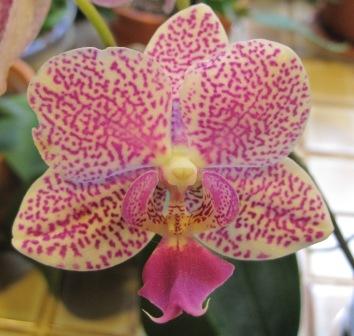
As to the second question – why does it look this way – there could be a number of reasons. I’m leaning toward environmental. This particular flower stalk is an old one – after it had bloomed initially (with normal flowers), we left it on after the flowers fell. As often happens, new flower buds appeared, but all of them have been abnormal. Some were completely fused and never opened. This one is missing most of its petals.
Other reasons could include viral infection (as Sheila suggested) or somaclonal variation (common in tissue cultured plants, which is how many orchids are propagated). But this flower stalk is perpetually colder than the rest of the plant as it’s closest to the window. And since its first crop of flowers were normal, I think this variation is due to cold temperature interference during flower development.
If you have other ideas, be sure to post them!
Just got a picture of the cover of a new book I’ve got coming up soon. It’s a collaborative project with an old friend of mine who is a political science professor at UNC Charlotte. We look at a bunch of different environmental issues, different things that the government could do about these issues, and then we rate these options by how the well the right and left wingers would like them. Sure to tick people off! The book won’t be out till next January — It’s typically over a year between when something is first turned in and when it comes out — that’s just publishing.
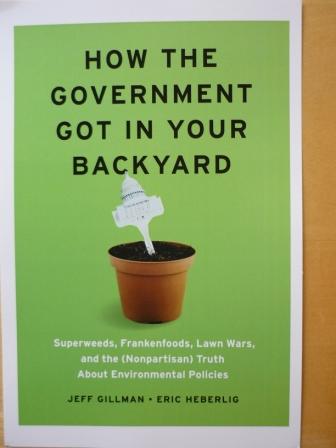
We’ve had some good, vigorous discussion about permaculture, specifically around the book Gaia’s Garden. I’ve pointed out some problems with the author’s understanding of relevant plant and soil sciences and will wrap up this week with a look at the glossary and bibliography.
Glossary
The glossary contains a number of scientific-sounding words and phrases with unscientific definitions; for example:
“Buffer plants: Plants placed between guilds or between allelopathic species. They should be compatible with the trees in each guild and should have a positive effect on one or both of the guilds to be linked.” (“Buffer plants” is a phrase legitimately used in ecological restoration where plantings separate wetlands or other natural areas from human activity.)
“Guild: A harmoniously interwoven group of plants and animals, often centered around one major species, that benefits humans while creating habitat.” (The term “guild” is ecological and refers to groups of species that exploit the same types of resources. It has been hijacked and redefined for permaculture.)
“Narcissistic: Plants that thrive on the leaf litter of members of their own family, such as the Solanaceae, or nightshade family.” (In this case, this is an unscientific term given a scientific-sounding – but nonsensical – definition.)
“Polycultures: Dynamic, self-organizing plant communities composed of several to many species.” (Polyculture is an agricultural term referring to the planting of multiple crops. It’s a cultural strategy in Integrated Pest Management.)
“Sectors: Areas where outside energies such as wind, sun, fire and so forth enter a site. These energies can be mitigated, captured, or otherwise influenced by placement of elements in the design.”
Bibliography
There are only two books I would consider scientific; one soils textbook from 1996 and the other is Odum’s classic text Fundamentals of Ecology (1971). I’m disappointed in how scarce and dated these references are, given the wealth of more recent articles and books that are both relevant to urban gardens and scientifically sound.
The bibliography also includes many books on design and I’m not including them in this critique. Of those that remain, the bulk are nonscientific and in many cases pseudoscientific. Examples of the latter include The Albrecht Papers (Albrecht, 1996), Weeds and What They Tell (Pfeiffer, 1981).
And this last criticism embodies what permeates much of Gaia’s Garden: pseudoscience. In the glossary, we see scientific-sounding terms or definitions that are ultimately meaningless or incorrect. Furthermore, we see scientifically legitimate terms such as guild used incorrectly. Both of these practices are characteristics of a pseudoscience.
I think this is unfortunate. I’ve mentioned before that I agree with much of the philosophy behind permaculture. But dressing up this philosophy as science both misleads nonexperts and alienates scientists.
So here’s a challenge – why not write a new book on permaculture and collaborate with a scientist? (I know a few who are writers!)
Mulch is always an interesting point of discussion as well as the topic of several past GP posts. But I honestly can’t recall if we’ve covered dyed mulch, and can’t search the site, so here goes.
I recently received a request for information from Debbie Dillon, a fine Urban Horticulturist with Virginia Cooperative Extension. She noted the increased use of dyed mulch in the Northern Virginia area, and has been fielding questions from both landscape designers and homeowners regarding the safety of said mulch and the potential for harmful effects on plants. Black seems to be a fave color of late.
All I could offer her at the time was “Bleccch, I really don’t care for it” and a promise to investigate further. Armed with a bit of spare time and Google – here’s what [little] I’ve found out.
There are several products out there, such as Solarfast MCH and Mulch Magic. They’re used commercially on bulk mulch and are also available to the homeowner without restriction. From the Solarfast website – “Solarfast MCH is a colorant used to restore faded mulch back to its original color. It is environmentally friendly and does not contain hazardous chemicals, heavy metals or other ingredients that are known to be harmful to the environment.”
Is it safe?
The MSDS (Material Safety Data Sheet) for Solarfast was incomplete – it did not list components. The MSDS for Mulch Magic indicates the black contains carbon black, red contains iron oxide, and brown contains diethylene glycol monobutyl ether (as well as carbon black and iron oxide). The composition beyond that (carriers, surfactants, etc.), was not noted. Diethylene glycol monobutyl ether is a fairly common solvent for paints and inks with purportedly low environmental toxicity, but can irritate skin and eyes. Carbon black can be made from various sources but is basically a petroleum product, used in laser printer and photocopier toner as well as the manufacture of reinforced rubber (i.e. tires). Most concerns are related to worker inhalation at the point of manufacture. Iron oxide is, well, oxidized iron, and has been used as a pigment for quite a while (i.e. cave paintings at Lascaux, Bob Ross, etc.).
What about the plants?
There are many, many studies on pigmented film mulches (usually polyethylene) in fruit and vegetable production. Certain colors can alter plant growth and processes, such as flowering and fruiting, stem length, etc., but I couldn’t find a thing regarding dyed, wood-product mulch. Issues of concern might be that the dye is disguising the composition of the mulch. Apparently dyes are frequently used on “pallet mulch” – shredded pallets, usually made from softwood. Another concern might be the increase in root-zone temperature, especially from the use of heat-absorbing black pigments. Could soil temperatures warm to the point of causing a too-early bud break?
Is it aesthetically pleasing?
Apparently “yes”, to some, because there’s a market for it. What do you think?

This photo was taken in April at a local medical center (it was a rainy morning, pardon the low light). The fairly typical commercial landscape surrounding the building is dotted with beds and trees freshly mulched in black. Note the classic mulch “volcano” in the background. No sir, I don’t like it. But that’s just me.
Toxicity information on compounds noted available at the International Agency for Research on Cancer (IARC) – Summaries & Evaluations, http://www.inchem.org/